THE DEVIL IS IN THE DETAILS IDTECH 666
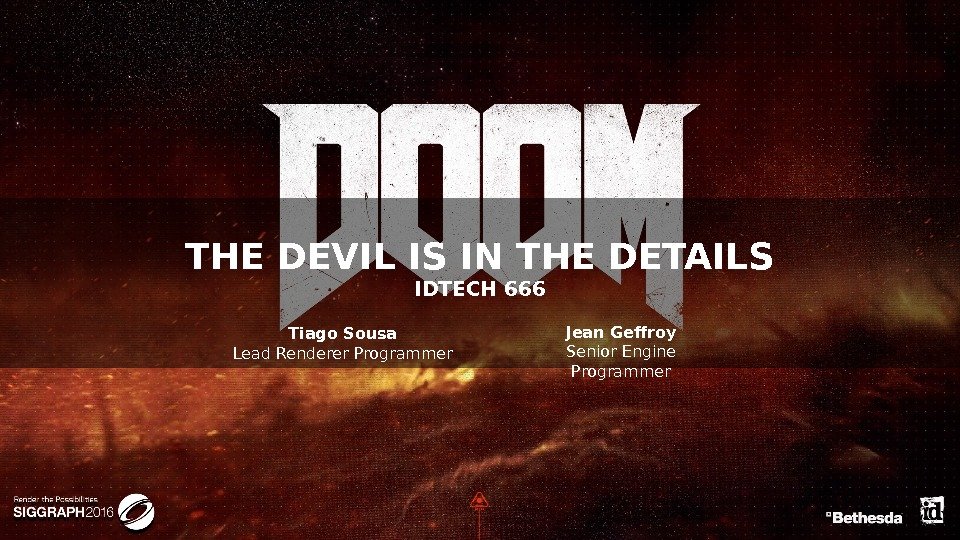
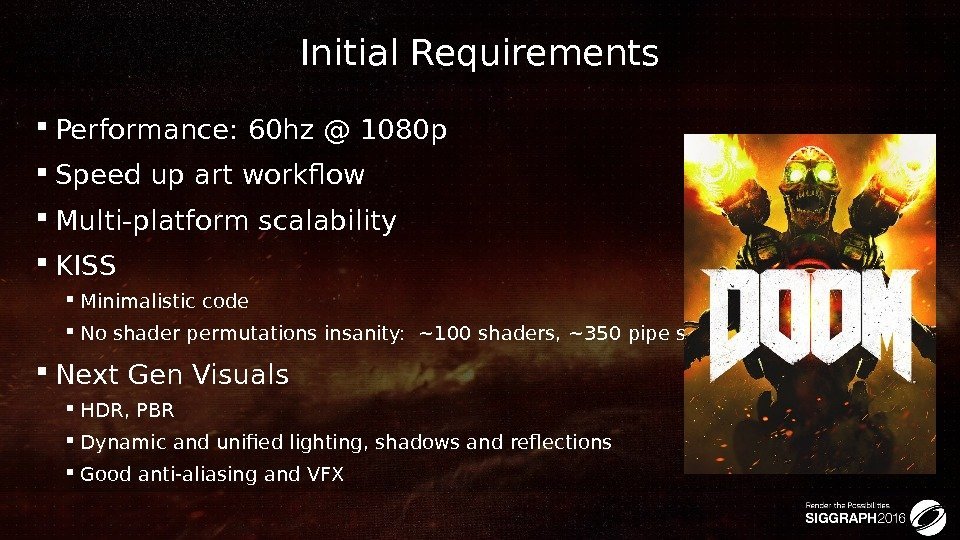
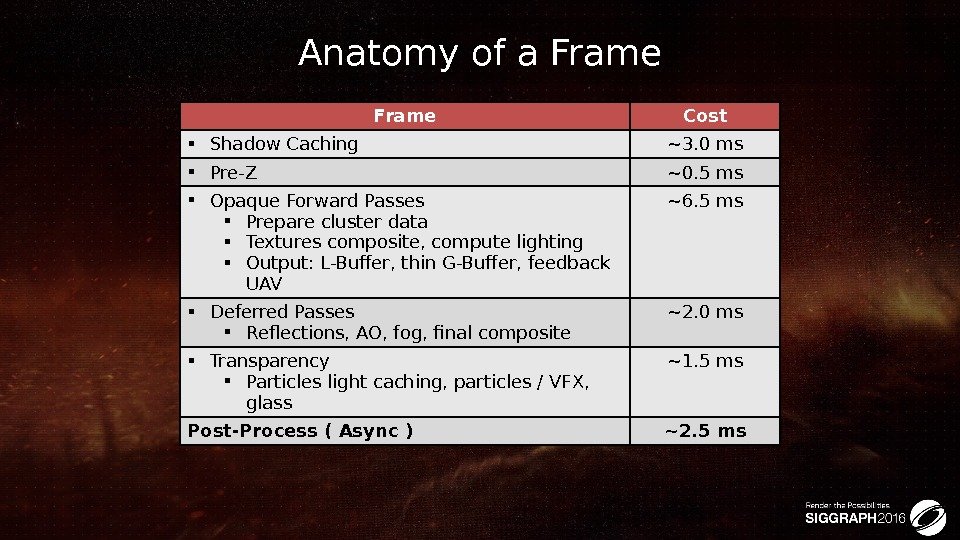
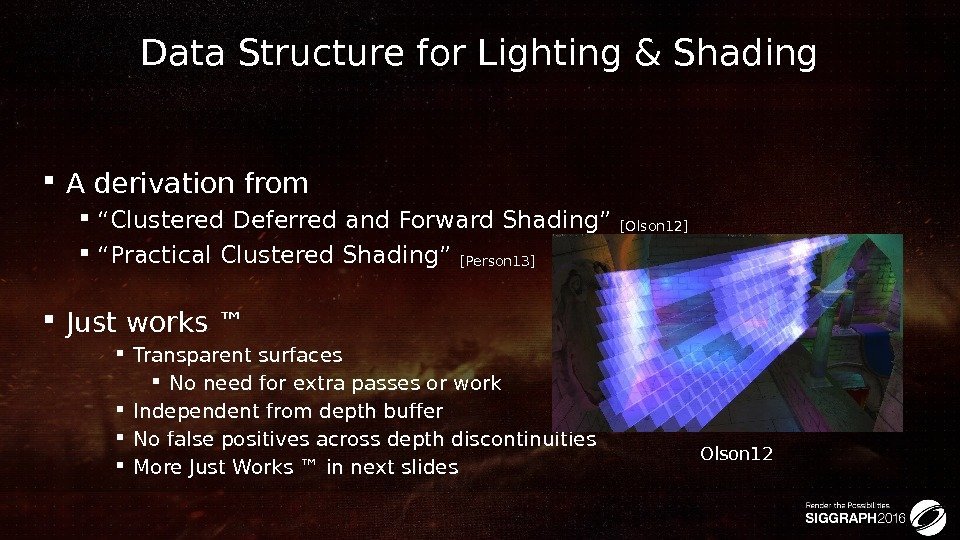
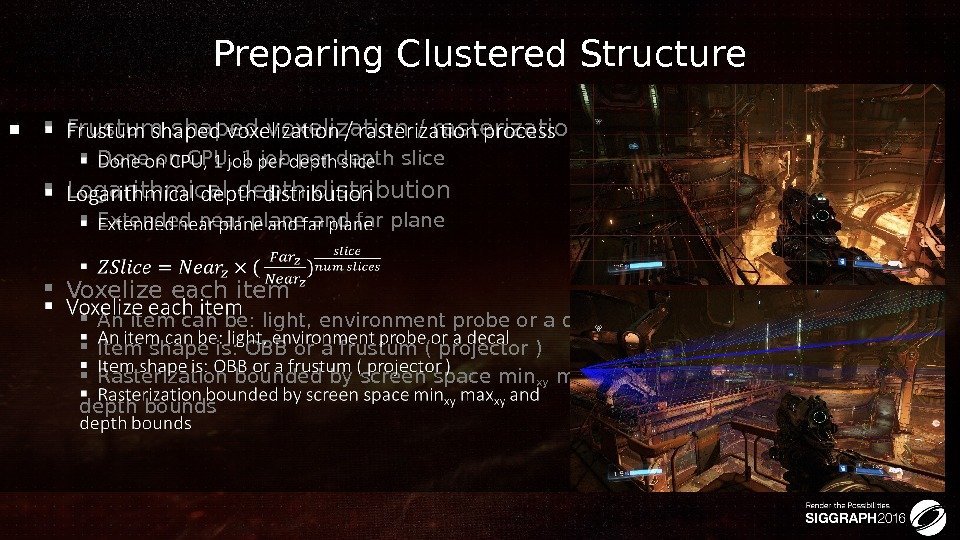
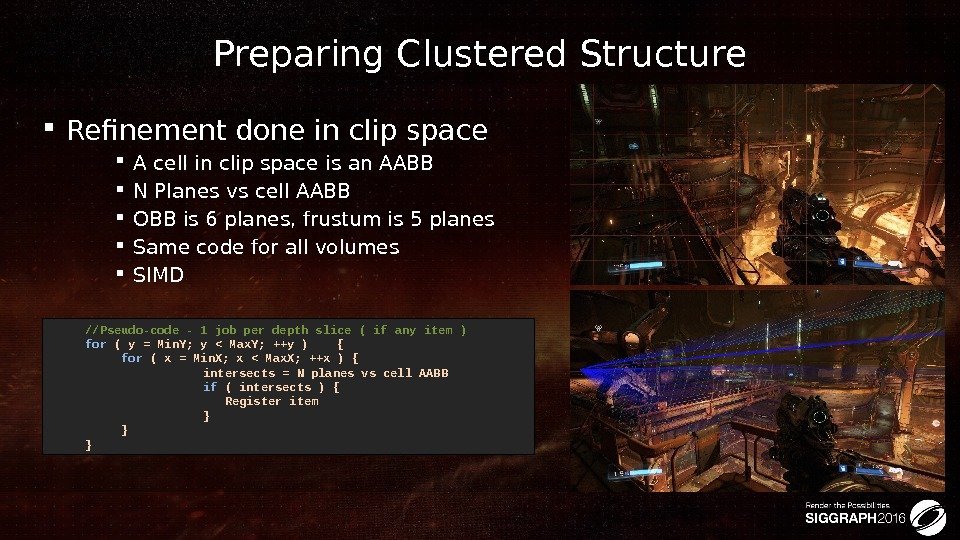
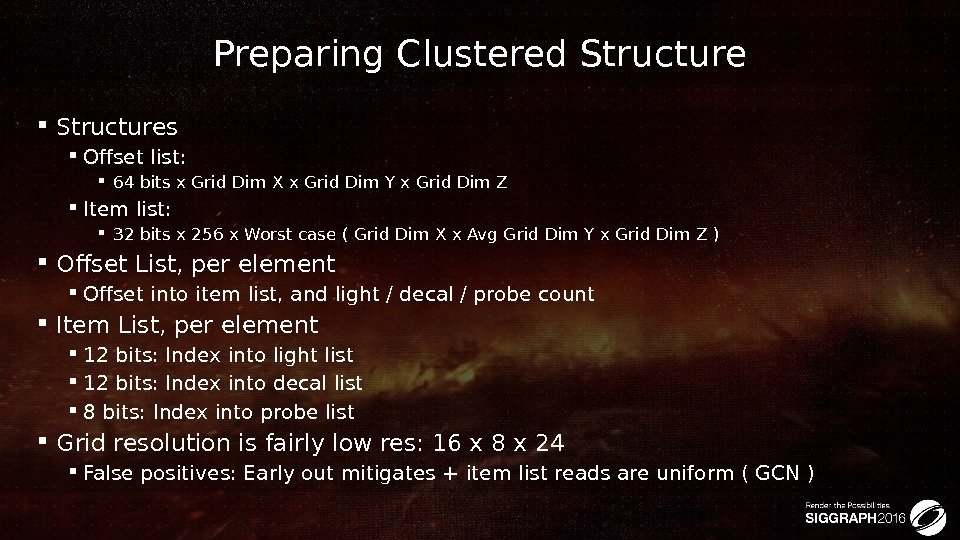
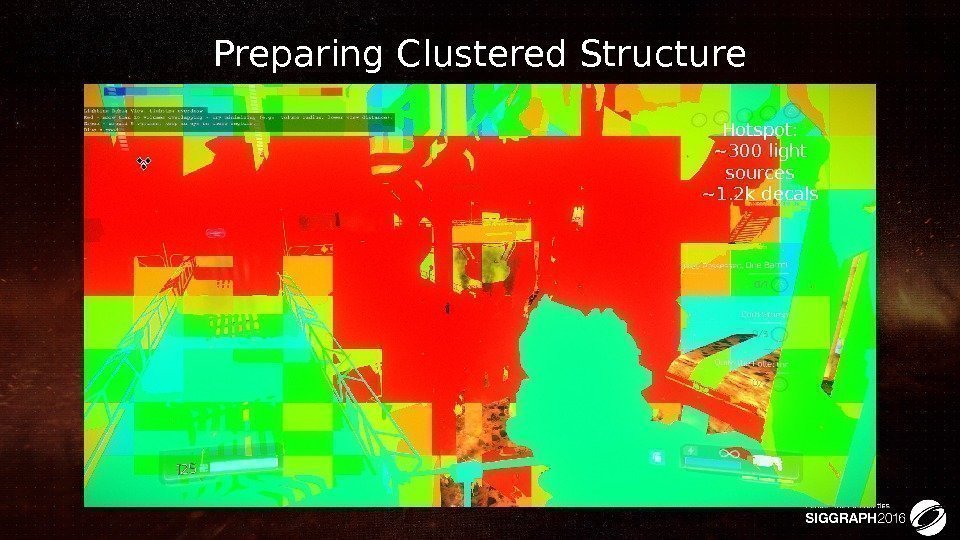
![Detailing the World Virtual-Texturing [10] updates Albedo, Specular, Smoothness, Normals, HDR Lightmap HW s. Detailing the World Virtual-Texturing [10] updates Albedo, Specular, Smoothness, Normals, HDR Lightmap HW s.](http://present5.com/presentforday2/20170304/siggraph2016_idtech6_images/siggraph2016_idtech6_8.jpg)
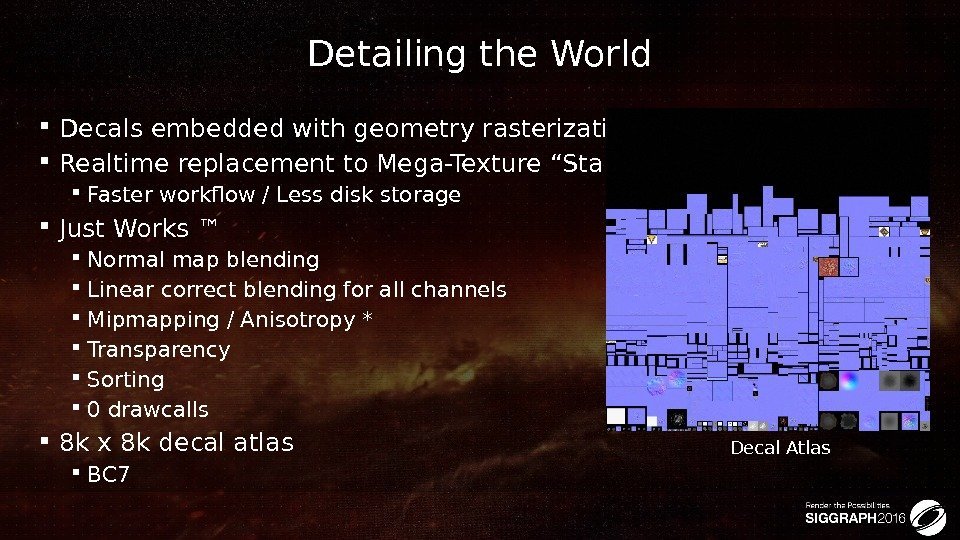
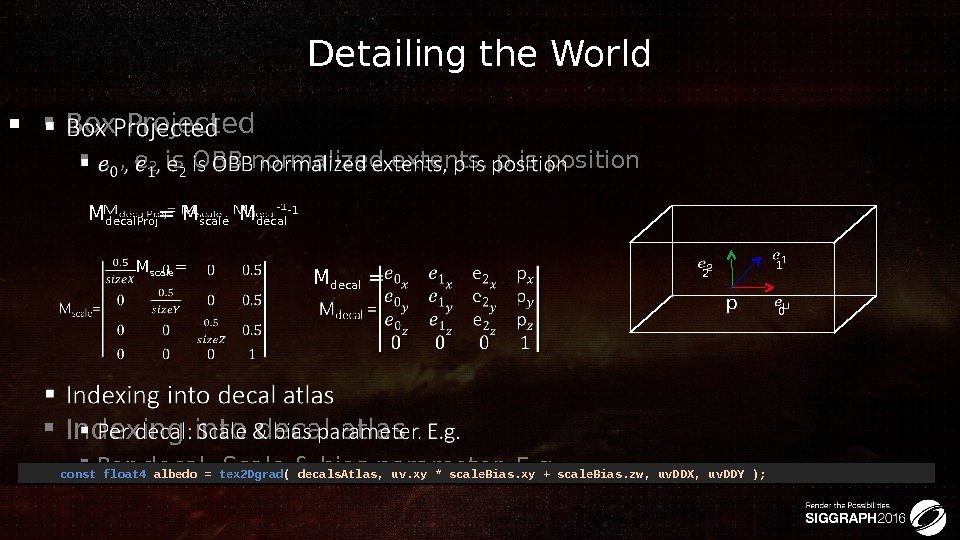
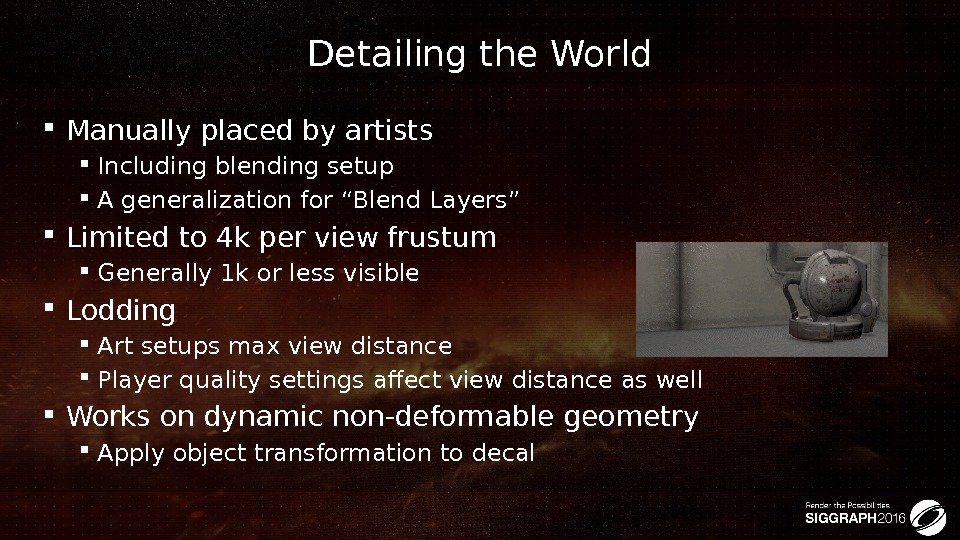
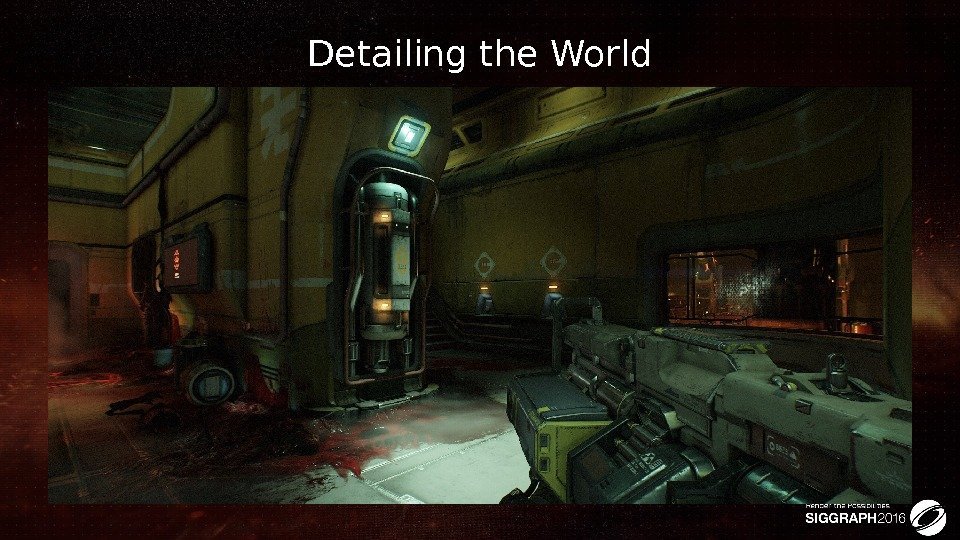
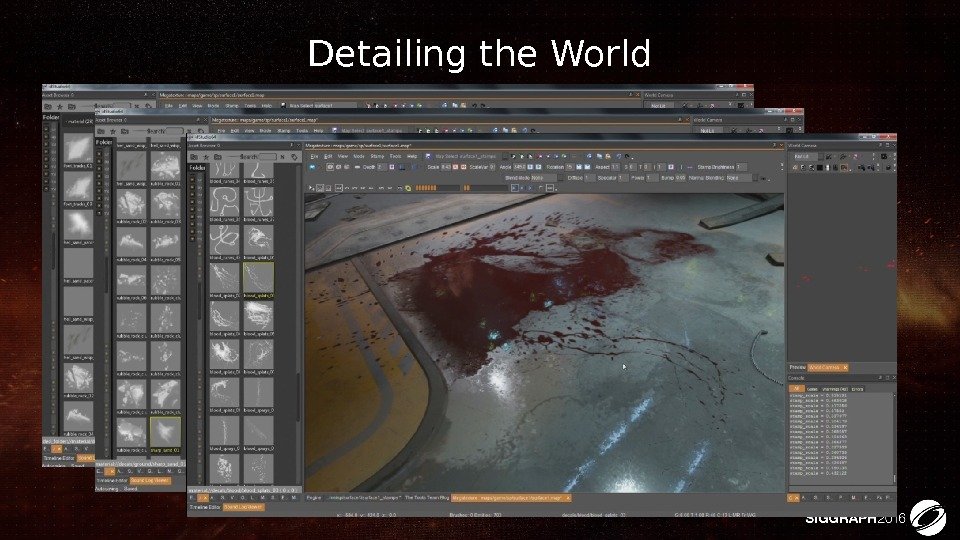
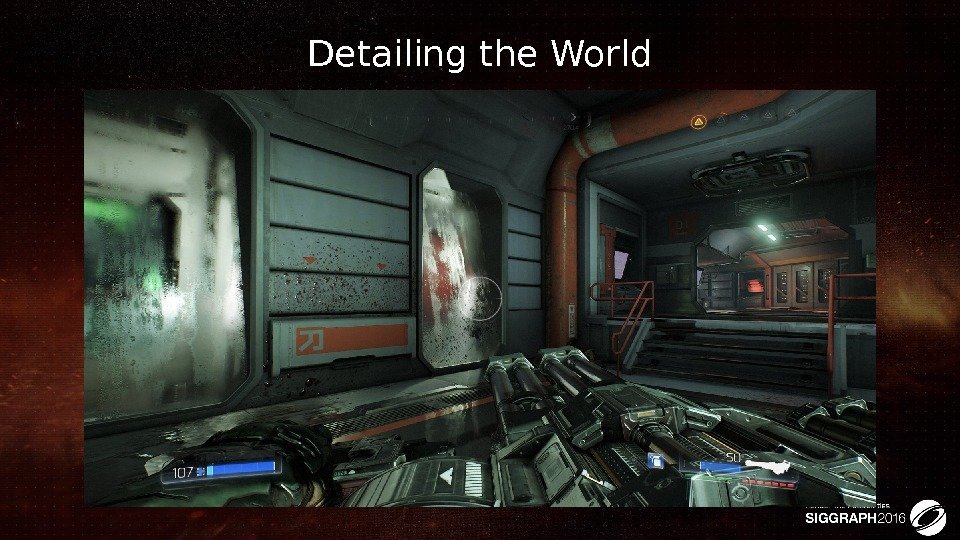
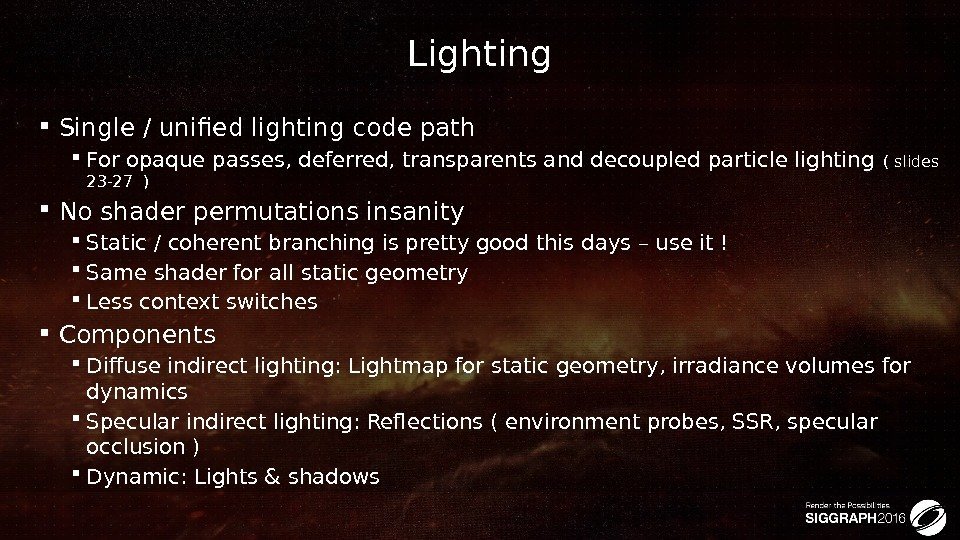
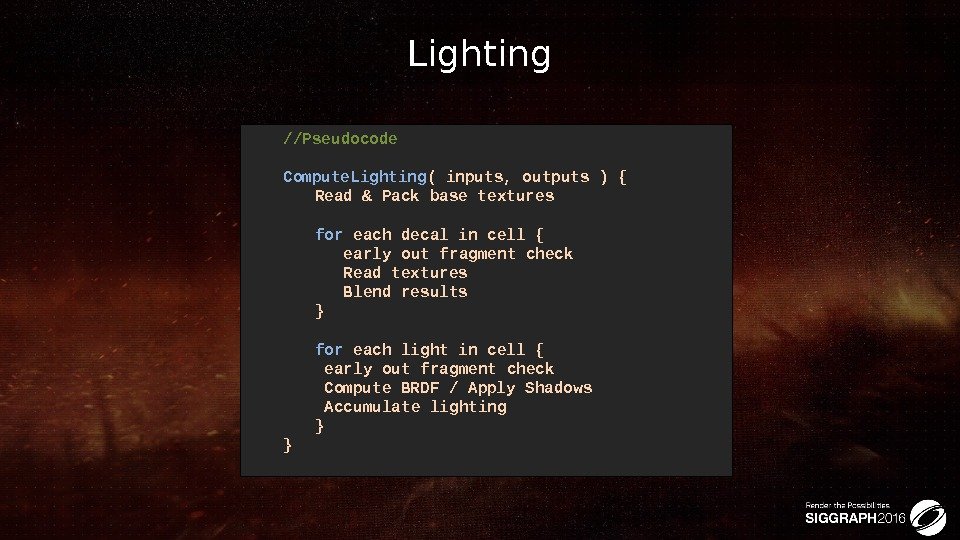
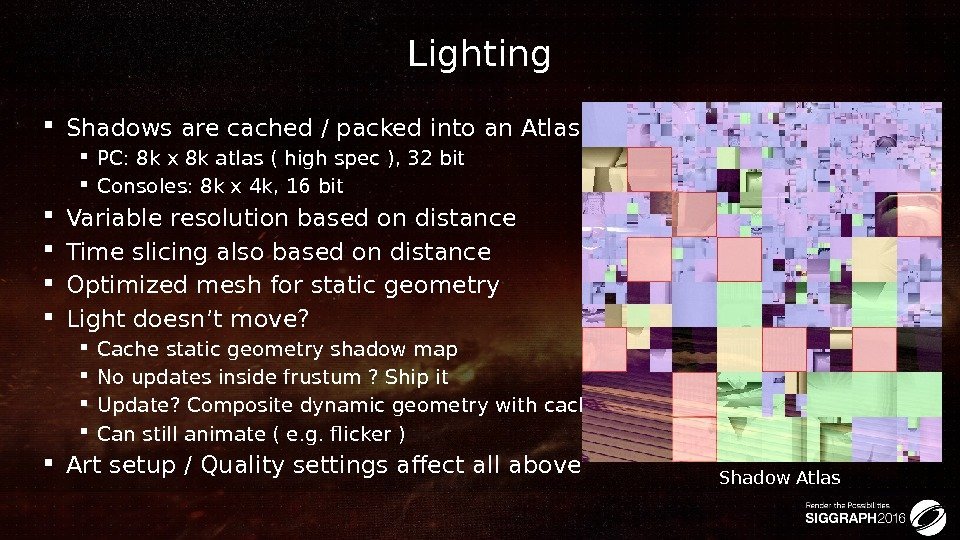
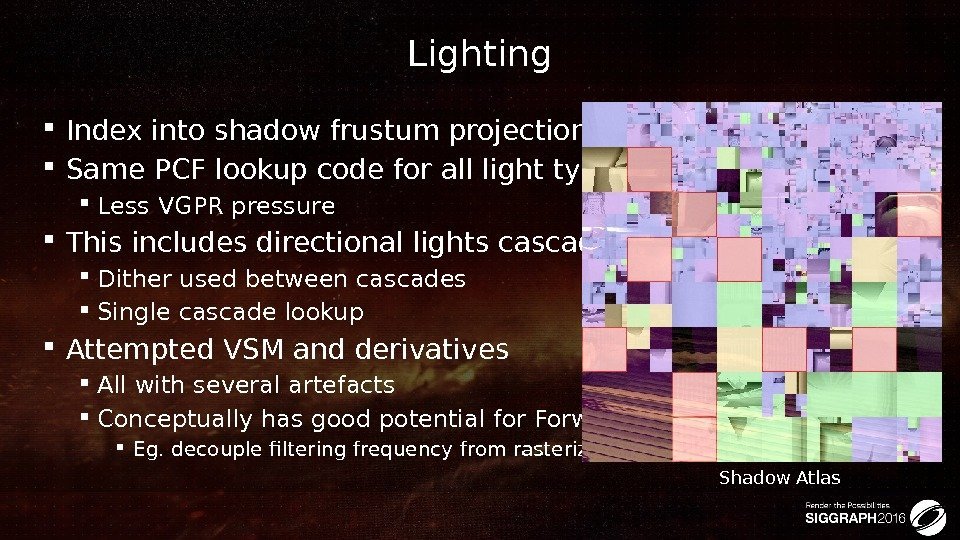
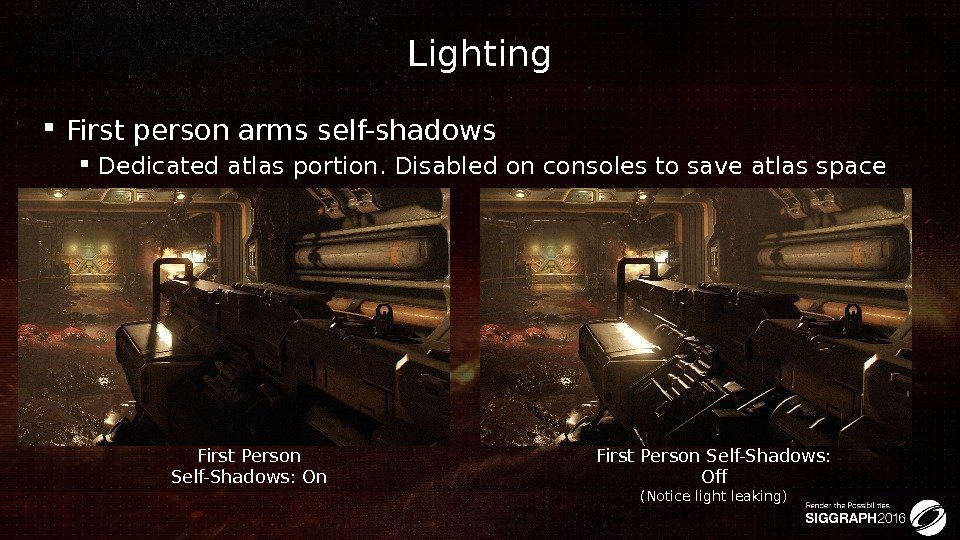
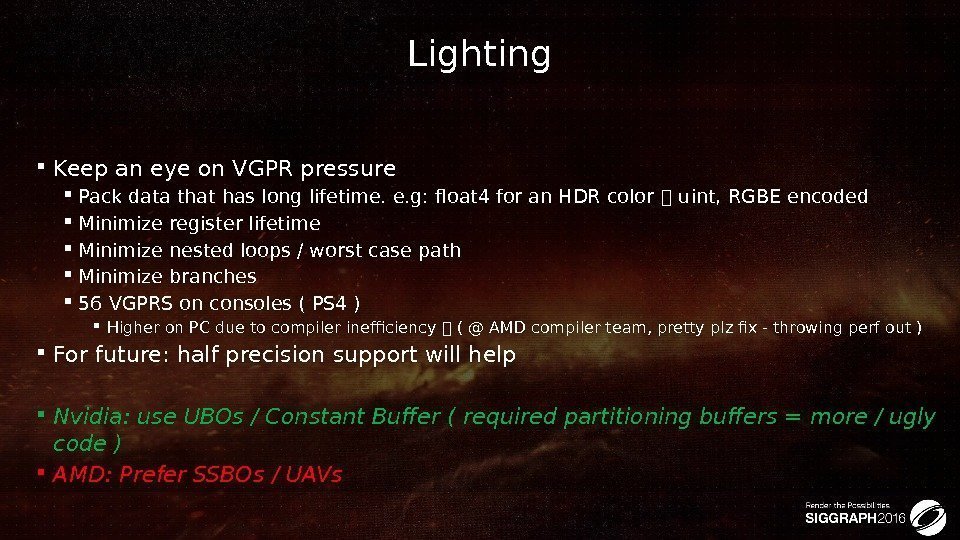
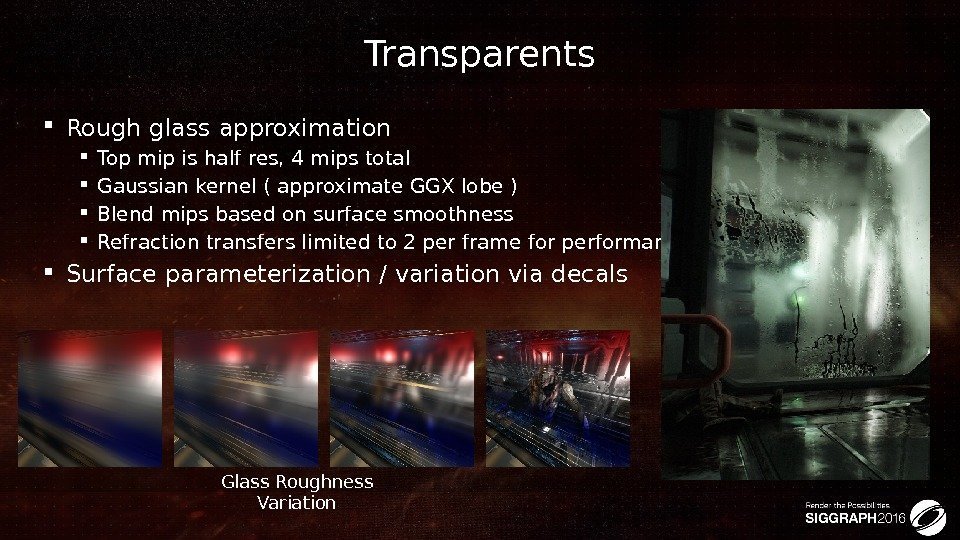
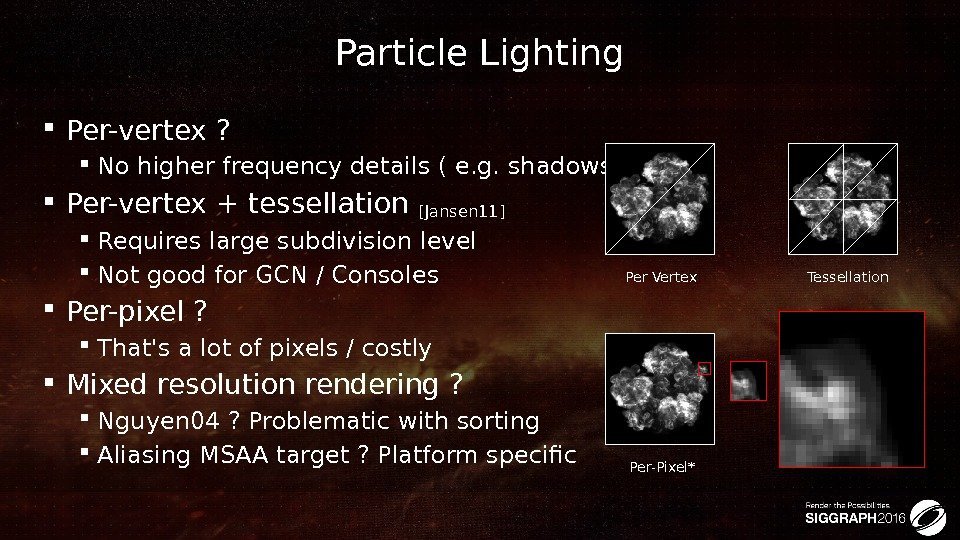
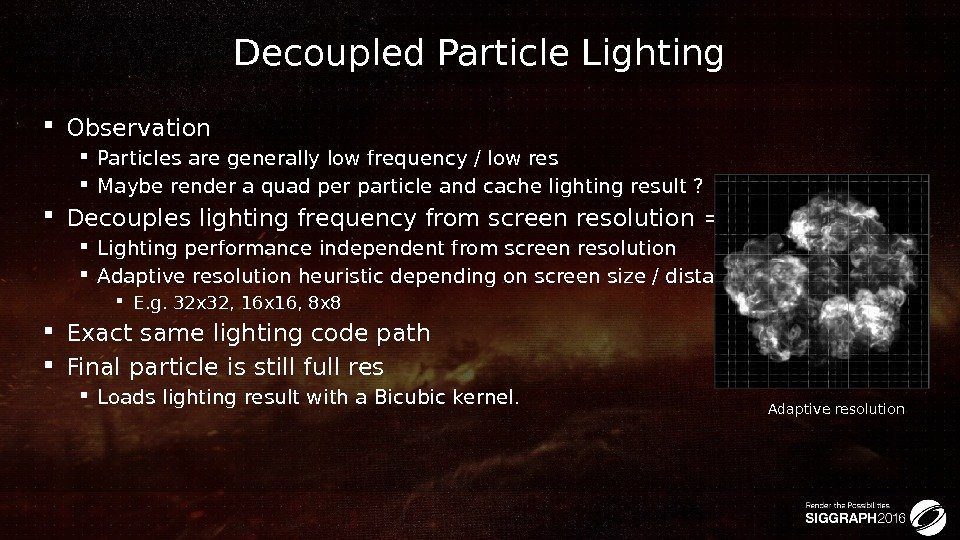
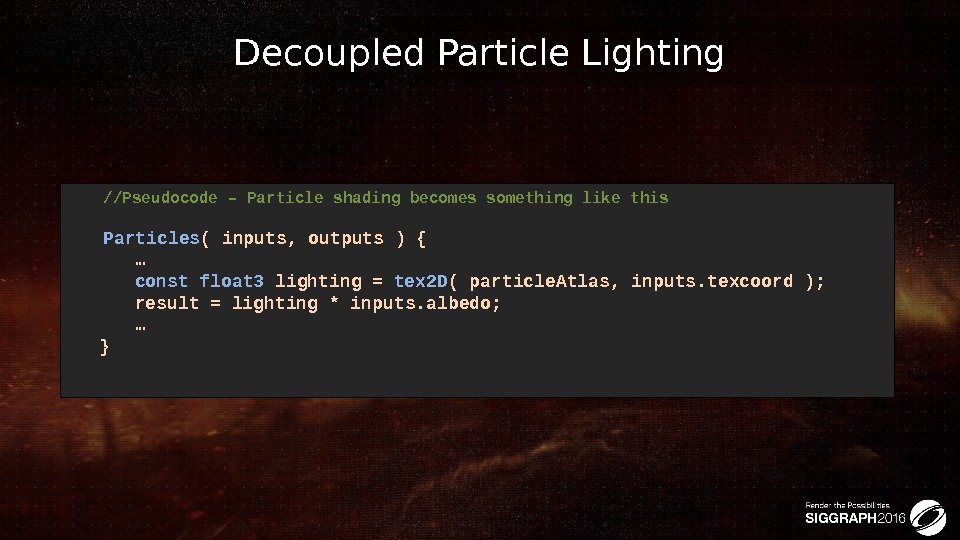
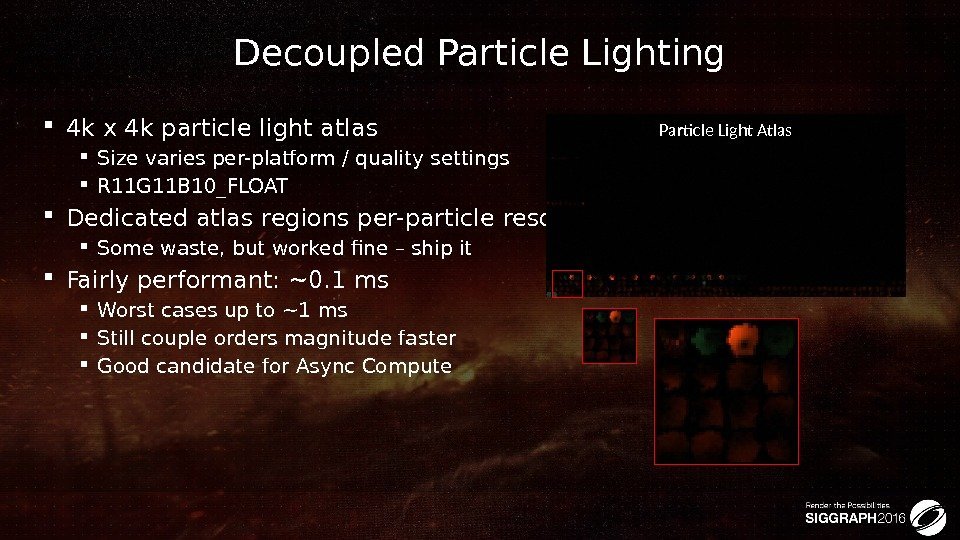
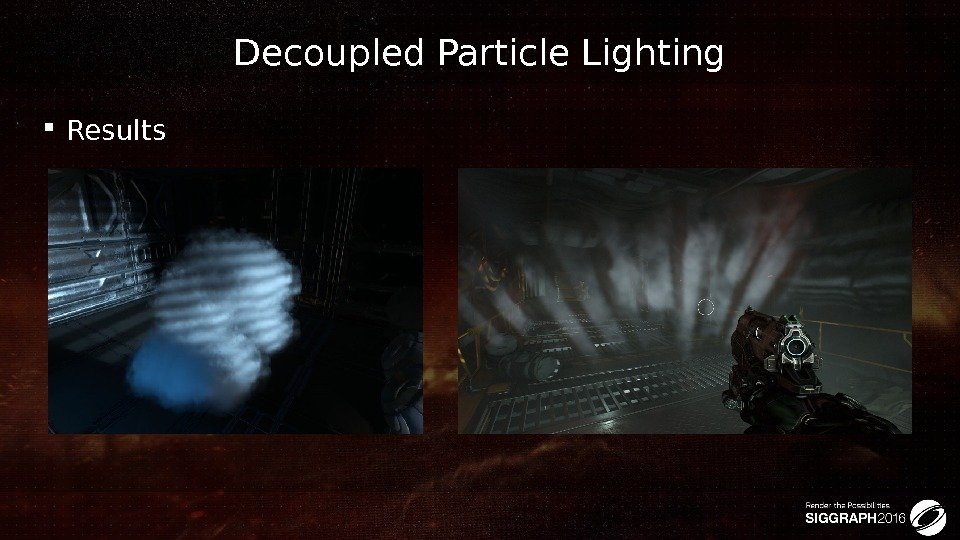
![Post-Process [Sousa 13] Post-Process [Sousa 13]](http://present5.com/presentforday2/20170304/siggraph2016_idtech6_images/siggraph2016_idtech6_27.jpg)
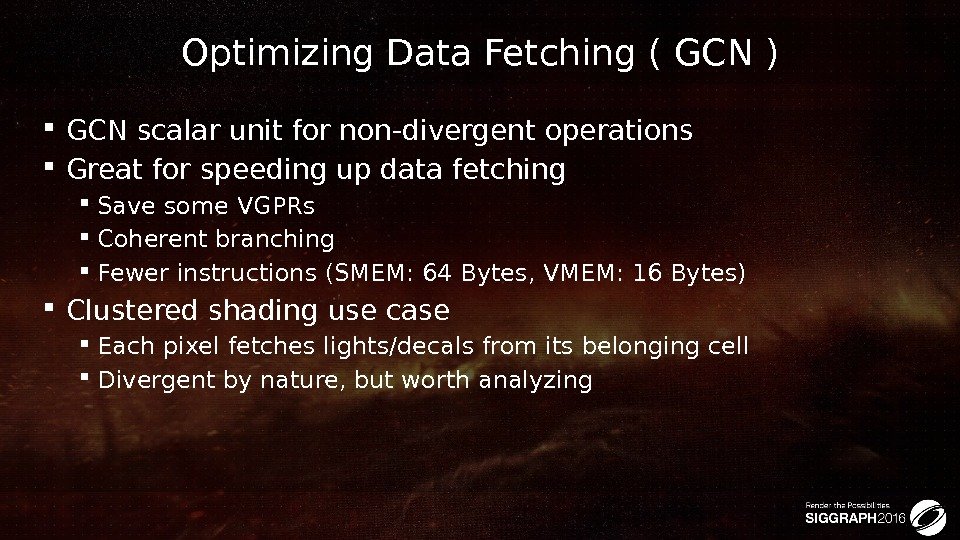
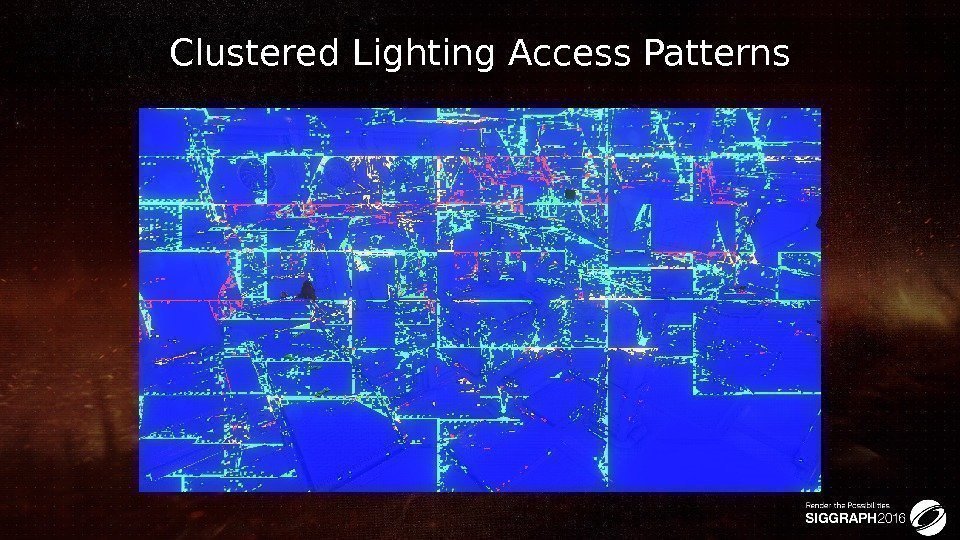
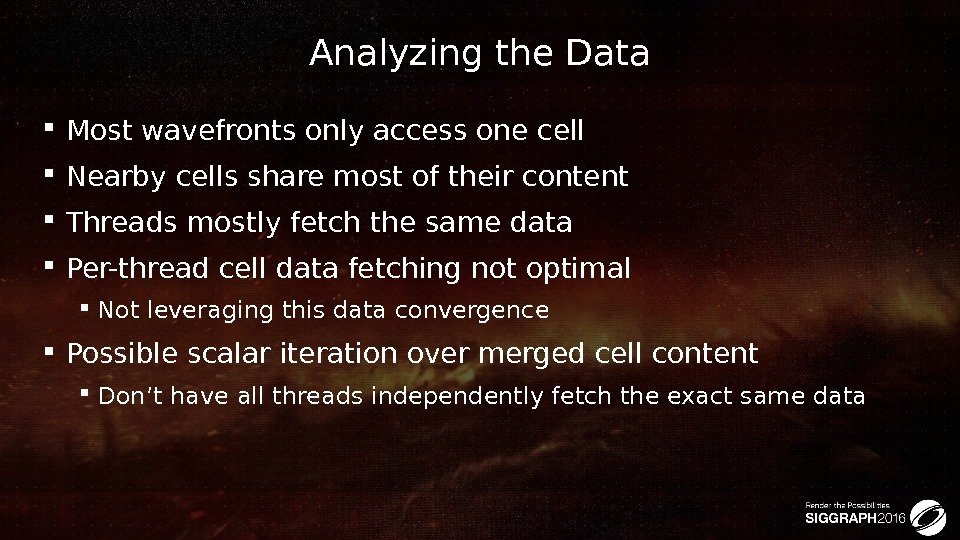
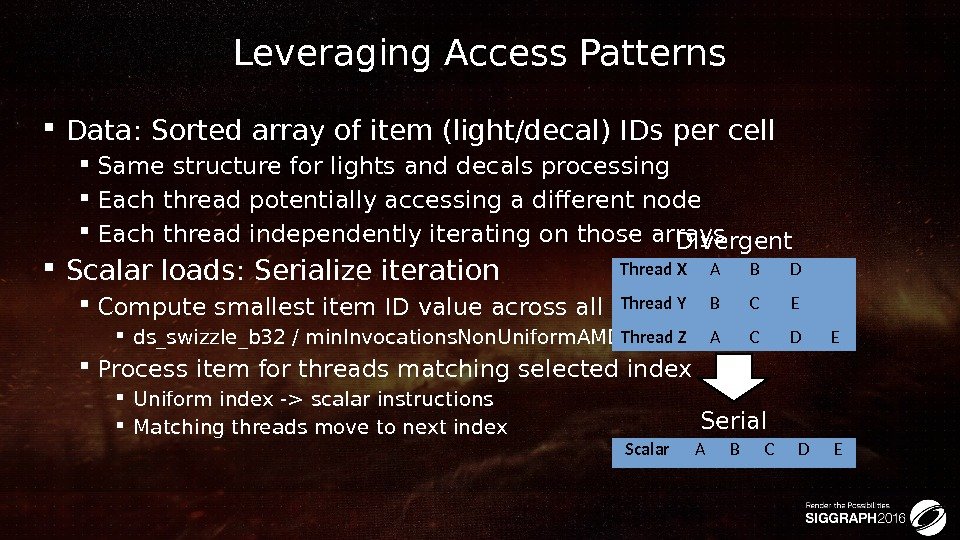
![Special Paths Fast path if touching only one cell [Fuller 15] Avoid computing smallest Special Paths Fast path if touching only one cell [Fuller 15] Avoid computing smallest](http://present5.com/presentforday2/20170304/siggraph2016_idtech6_images/siggraph2016_idtech6_32.jpg)
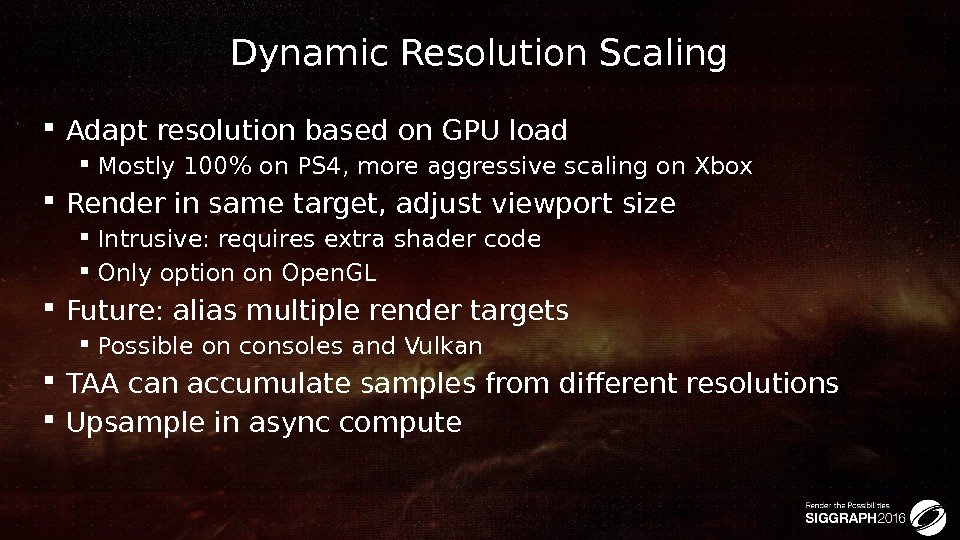
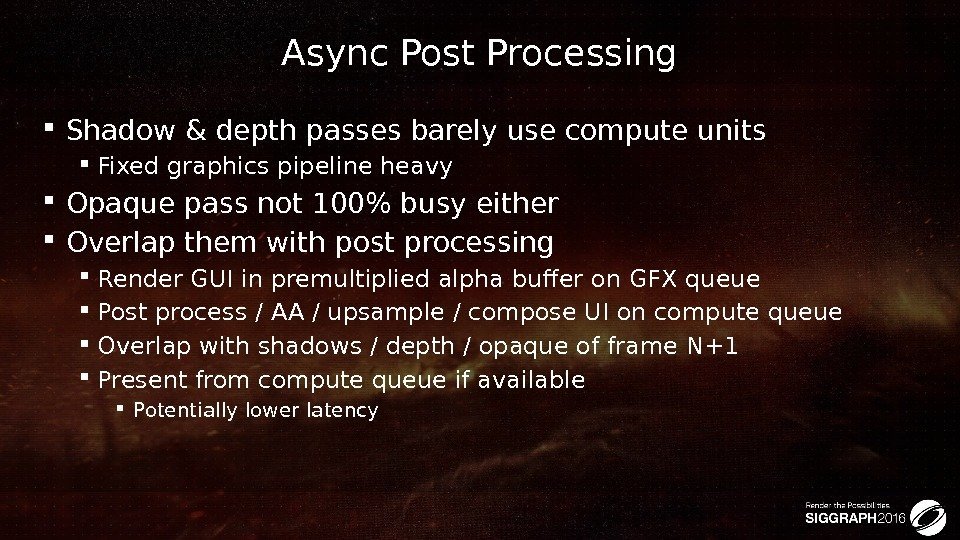
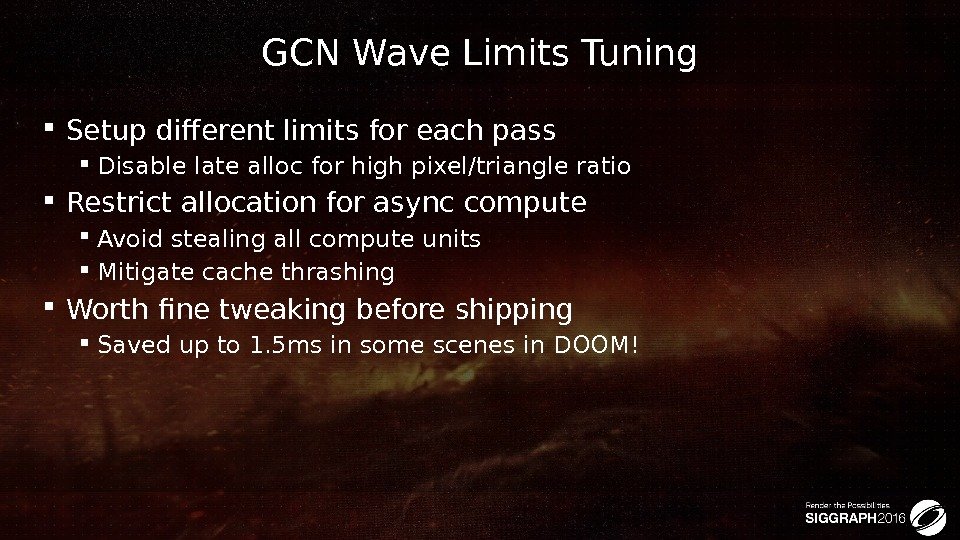
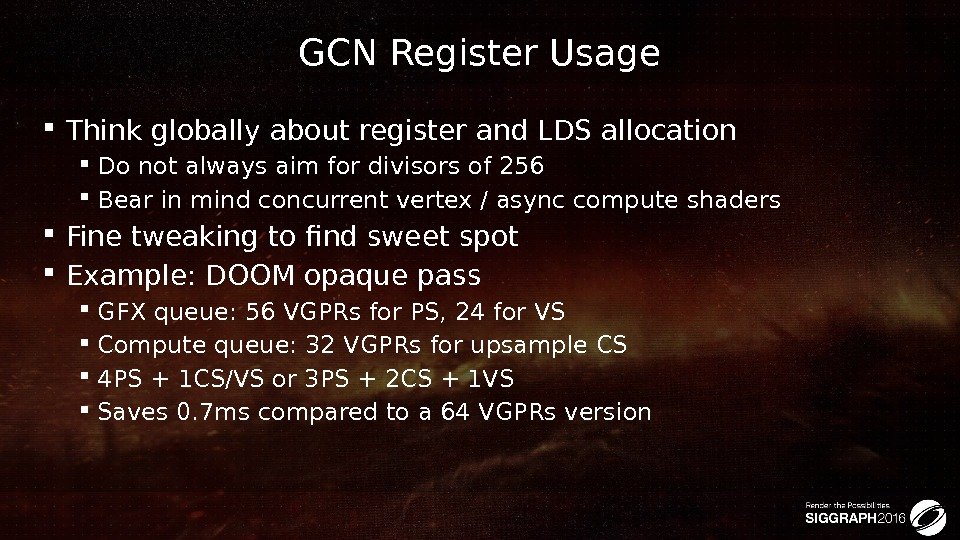
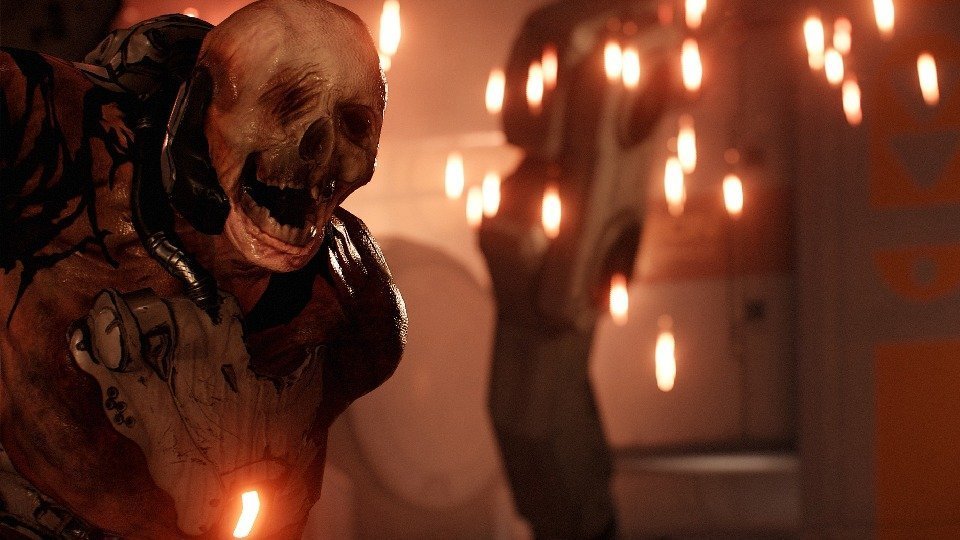
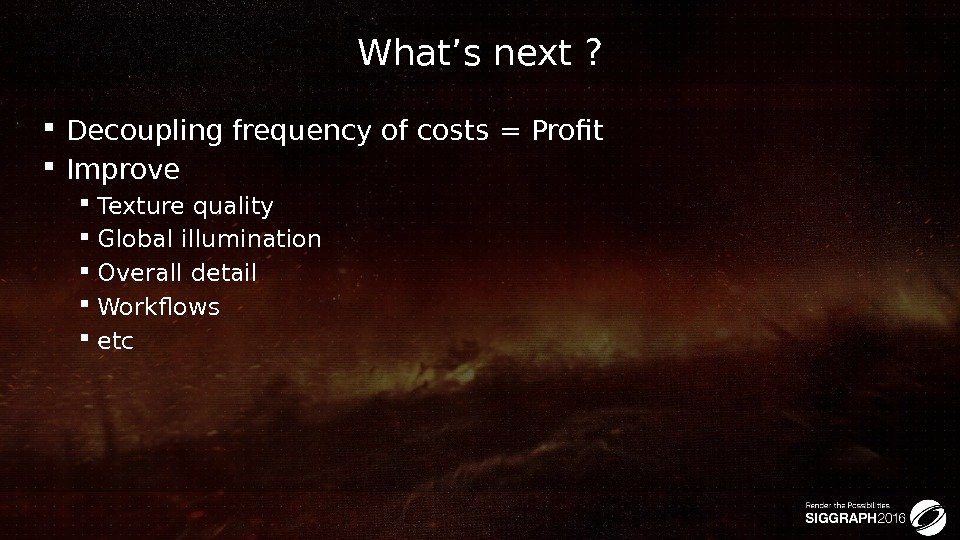
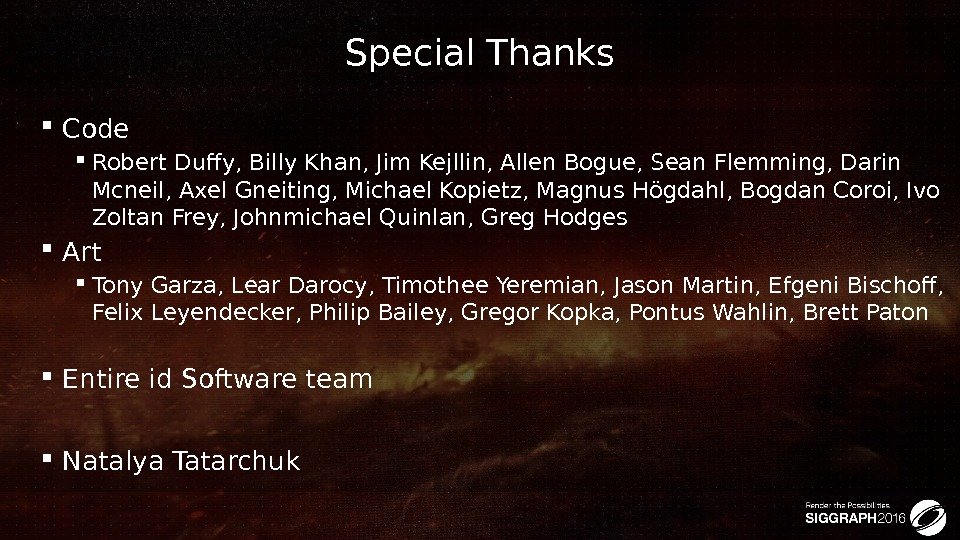
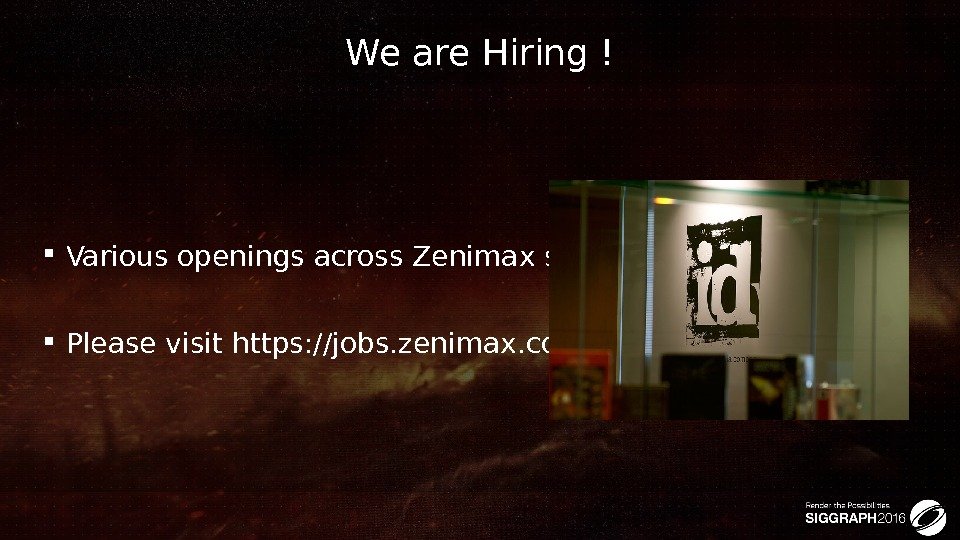

![References [1] “Clustered Deferred and Forward Shading”, Ola Olson et al. , HPG 2012 References [1] “Clustered Deferred and Forward Shading”, Ola Olson et al. , HPG 2012](http://present5.com/presentforday2/20170304/siggraph2016_idtech6_images/siggraph2016_idtech6_42.jpg)
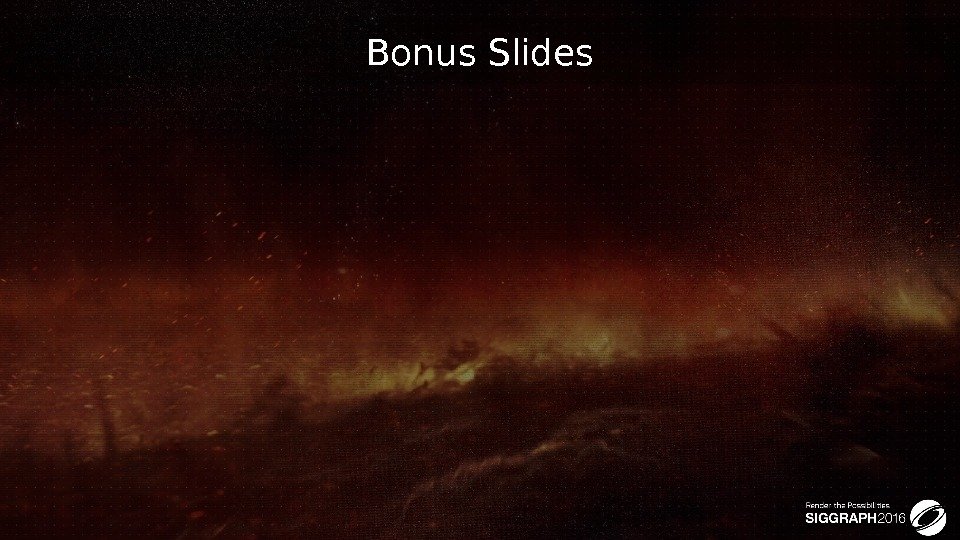
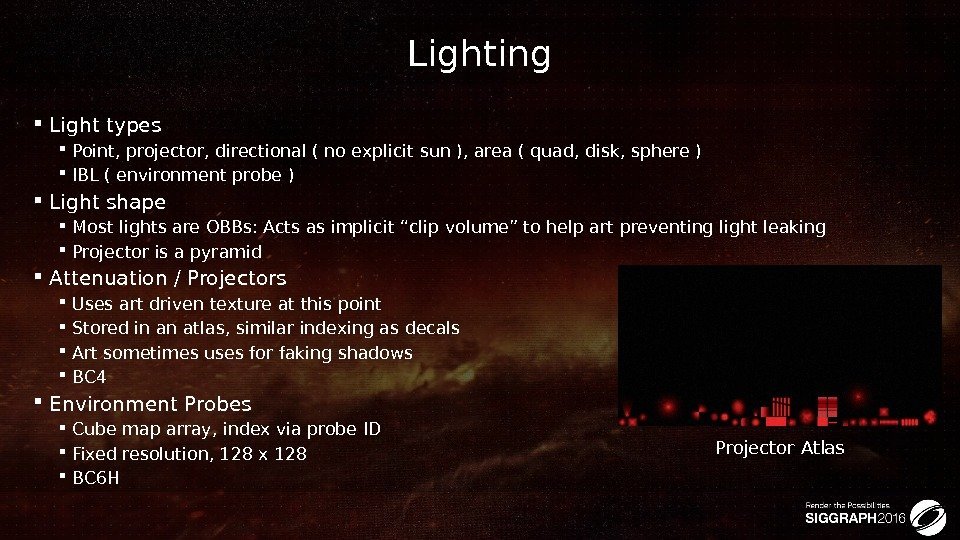
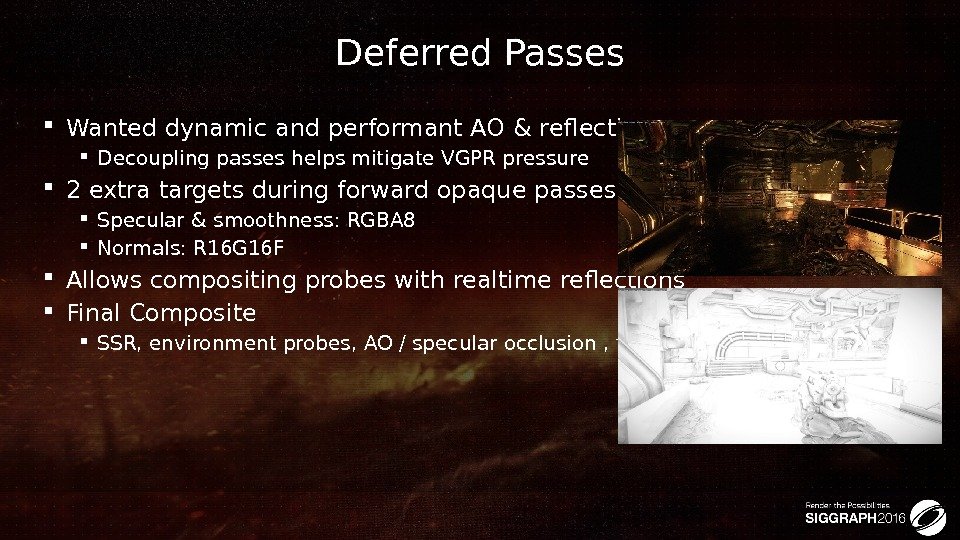
siggraph2016_idtech6.pptx
- Размер: 46.7 Мб
- Автор:
- Количество слайдов: 46
Описание презентации THE DEVIL IS IN THE DETAILS IDTECH 666 по слайдам
 THE DEVIL IS IN THE DETAILS IDTECH 666 Tiago Sousa Lead Renderer Programmer Jean Geffroy Senior Engine Programmer
THE DEVIL IS IN THE DETAILS IDTECH 666 Tiago Sousa Lead Renderer Programmer Jean Geffroy Senior Engine Programmer
 Initial Requirements Performance: 60 hz @ 1080 p Speed up art workflow Multi-platform scalability KISS Minimalistic code No shader permutations insanity: ~100 shaders, ~350 pipe states Next Gen Visuals HDR, PBR Dynamic and unified lighting, shadows and reflections Good anti-aliasing and VFX
Initial Requirements Performance: 60 hz @ 1080 p Speed up art workflow Multi-platform scalability KISS Minimalistic code No shader permutations insanity: ~100 shaders, ~350 pipe states Next Gen Visuals HDR, PBR Dynamic and unified lighting, shadows and reflections Good anti-aliasing and VFX
 Anatomy of a Frame Cost Shadow Caching ~3. 0 ms Pre-Z ~0. 5 ms Opaque Forward Passes Prepare cluster data Textures composite, compute lighting Output: L-Buffer, thin G-Buffer, feedback UAV ~6. 5 ms Deferred Passes Reflections, AO, fog, final composite ~2. 0 ms Transparency Particles light caching, particles / VFX, glass ~1. 5 ms Post-Process ( Async ) ~2. 5 ms
Anatomy of a Frame Cost Shadow Caching ~3. 0 ms Pre-Z ~0. 5 ms Opaque Forward Passes Prepare cluster data Textures composite, compute lighting Output: L-Buffer, thin G-Buffer, feedback UAV ~6. 5 ms Deferred Passes Reflections, AO, fog, final composite ~2. 0 ms Transparency Particles light caching, particles / VFX, glass ~1. 5 ms Post-Process ( Async ) ~2. 5 ms
 Data Structure for Lighting & Shading A derivation from “ Clustered Deferred and Forward Shading” [Olson 12] “ Practical Clustered Shading” [Person 13] Just works ™ Transparent surfaces No need for extra passes or work Independent from depth buffer No false positives across depth discontinuities More Just Works ™ in next slides Olson
Data Structure for Lighting & Shading A derivation from “ Clustered Deferred and Forward Shading” [Olson 12] “ Practical Clustered Shading” [Person 13] Just works ™ Transparent surfaces No need for extra passes or work Independent from depth buffer No false positives across depth discontinuities More Just Works ™ in next slides Olson
 Preparing Clustered Structure Frustum shaped voxelization / rasterization process Done on CPU, 1 job per depth slice Logarithmical depth distribution Extended near plane and far plane Voxelize each item An item can be: light, environment probe or a decal Item shape is: OBB or a frustum ( projector ) Rasterization bounded by screen space min xy max xy and depth bounds
Preparing Clustered Structure Frustum shaped voxelization / rasterization process Done on CPU, 1 job per depth slice Logarithmical depth distribution Extended near plane and far plane Voxelize each item An item can be: light, environment probe or a decal Item shape is: OBB or a frustum ( projector ) Rasterization bounded by screen space min xy max xy and depth bounds
 Preparing Clustered Structure Refinement done in clip space A cell in clip space is an AABB N Planes vs cell AABB OBB is 6 planes, frustum is 5 planes Same code for all volumes SIMD //Pseudo-code — 1 job per depth slice ( if any item ) for ( y = Min. Y; y < Max. Y; ++y ) { for ( x = Min. X; x < Max. X; ++x ) { intersects = N planes vs cell AABB if ( intersects ) { Register item } } }
Preparing Clustered Structure Refinement done in clip space A cell in clip space is an AABB N Planes vs cell AABB OBB is 6 planes, frustum is 5 planes Same code for all volumes SIMD //Pseudo-code — 1 job per depth slice ( if any item ) for ( y = Min. Y; y < Max. Y; ++y ) { for ( x = Min. X; x < Max. X; ++x ) { intersects = N planes vs cell AABB if ( intersects ) { Register item } } }
 Preparing Clustered Structures Offset list: 64 bits x Grid Dim X x Grid Dim Y x Grid Dim Z Item list: 32 bits x 256 x Worst case ( Grid Dim X x Avg Grid Dim Y x Grid Dim Z ) Offset List, per element Offset into item list, and light / decal / probe count Item List, per element 12 bits: Index into light list 12 bits: Index into decal list 8 bits: Index into probe list Grid resolution is fairly low res: 16 x 8 x 24 False positives: Early out mitigates + item list reads are uniform ( GCN )
Preparing Clustered Structures Offset list: 64 bits x Grid Dim X x Grid Dim Y x Grid Dim Z Item list: 32 bits x 256 x Worst case ( Grid Dim X x Avg Grid Dim Y x Grid Dim Z ) Offset List, per element Offset into item list, and light / decal / probe count Item List, per element 12 bits: Index into light list 12 bits: Index into decal list 8 bits: Index into probe list Grid resolution is fairly low res: 16 x 8 x 24 False positives: Early out mitigates + item list reads are uniform ( GCN )
 Preparing Clustered Structure Hotspot: ~300 light sources ~1. 2 k decals
Preparing Clustered Structure Hotspot: ~300 light sources ~1. 2 k decals
![Detailing the World Virtual-Texturing [10] updates Albedo, Specular, Smoothness, Normals, HDR Lightmap HW s. Detailing the World Virtual-Texturing [10] updates Albedo, Specular, Smoothness, Normals, HDR Lightmap HW s.](http://present5.com/presentforday2/20170304/siggraph2016_idtech6_images/siggraph2016_idtech6_8.jpg) Detailing the World Virtual-Texturing [10] updates Albedo, Specular, Smoothness, Normals, HDR Lightmap HW s. RGB support Baked Toksvig[11, 12, 13, 14] into smoothness for specular anti-aliasing Feedback buffer UAV output directly to final resolution Async compute transcoding Cost mostly irrelevant Design flaws still present E. g. Reactive texture streaming = texture popping
Detailing the World Virtual-Texturing [10] updates Albedo, Specular, Smoothness, Normals, HDR Lightmap HW s. RGB support Baked Toksvig[11, 12, 13, 14] into smoothness for specular anti-aliasing Feedback buffer UAV output directly to final resolution Async compute transcoding Cost mostly irrelevant Design flaws still present E. g. Reactive texture streaming = texture popping
 Detailing the World Decals embedded with geometry rasterization Realtime replacement to Mega-Texture “Stamping” Faster workflow / Less disk storage Just Works ™ Normal map blending Linear correct blending for all channels Mipmapping / Anisotropy * Transparency Sorting 0 drawcalls 8 k x 8 k decal atlas BC 7 Decal Atlas
Detailing the World Decals embedded with geometry rasterization Realtime replacement to Mega-Texture “Stamping” Faster workflow / Less disk storage Just Works ™ Normal map blending Linear correct blending for all channels Mipmapping / Anisotropy * Transparency Sorting 0 drawcalls 8 k x 8 k decal atlas BC 7 Decal Atlas
 Detailing the World Box Projected , , e 2 is OBB normalized extents, p is position Indexing into decal atlas Per decal: Scale & bias parameter. E. g. const float 4 albedo = tex 2 Dgrad ( decals. Atlas, uv. xy * scale. Bias. xy + scale. Bias. zw, uv. DDX, uv. DDY ); 02 p 1 M decal =M scale = M decal. Proj = M scale M decal —
Detailing the World Box Projected , , e 2 is OBB normalized extents, p is position Indexing into decal atlas Per decal: Scale & bias parameter. E. g. const float 4 albedo = tex 2 Dgrad ( decals. Atlas, uv. xy * scale. Bias. xy + scale. Bias. zw, uv. DDX, uv. DDY ); 02 p 1 M decal =M scale = M decal. Proj = M scale M decal —
 Detailing the World Manually placed by artists Including blending setup A generalization for “Blend Layers” Limited to 4 k per view frustum Generally 1 k or less visible Lodding Art setups max view distance Player quality settings affect view distance as well Works on dynamic non-deformable geometry Apply object transformation to decal
Detailing the World Manually placed by artists Including blending setup A generalization for “Blend Layers” Limited to 4 k per view frustum Generally 1 k or less visible Lodding Art setups max view distance Player quality settings affect view distance as well Works on dynamic non-deformable geometry Apply object transformation to decal
 Detailing the World
Detailing the World
 Detailing the World
Detailing the World
 Detailing the World
Detailing the World
 Lighting Single / unified lighting code path For opaque passes, deferred, transparents and decoupled particle lighting ( slides 23 -27 ) No shader permutations insanity Static / coherent branching is pretty good this days – use it ! Same shader for all static geometry Less context switches Components Diffuse indirect lighting: Lightmap for static geometry, irradiance volumes for dynamics Specular indirect lighting: Reflections ( environment probes, SSR, specular occlusion ) Dynamic: Lights & shadows
Lighting Single / unified lighting code path For opaque passes, deferred, transparents and decoupled particle lighting ( slides 23 -27 ) No shader permutations insanity Static / coherent branching is pretty good this days – use it ! Same shader for all static geometry Less context switches Components Diffuse indirect lighting: Lightmap for static geometry, irradiance volumes for dynamics Specular indirect lighting: Reflections ( environment probes, SSR, specular occlusion ) Dynamic: Lights & shadows
 Lighting //Pseudocode Compute. Lighting ( inputs, outputs ) { Read & Pack base textures for each decal in cell { early out fragment check Read textures Blend results } for each light in cell { early out fragment check Compute BRDF / Apply Shadows Accumulate lighting } }
Lighting //Pseudocode Compute. Lighting ( inputs, outputs ) { Read & Pack base textures for each decal in cell { early out fragment check Read textures Blend results } for each light in cell { early out fragment check Compute BRDF / Apply Shadows Accumulate lighting } }
 Lighting Shadows are cached / packed into an Atlas PC: 8 k x 8 k atlas ( high spec ), 32 bit Consoles: 8 k x 4 k, 16 bit Variable resolution based on distance Time slicing also based on distance Optimized mesh for static geometry Light doesn’t move? Cache static geometry shadow map No updates inside frustum ? Ship it Update? Composite dynamic geometry with cached result Can still animate ( e. g. flicker ) Art setup / Quality settings affect all above Shadow Atlas
Lighting Shadows are cached / packed into an Atlas PC: 8 k x 8 k atlas ( high spec ), 32 bit Consoles: 8 k x 4 k, 16 bit Variable resolution based on distance Time slicing also based on distance Optimized mesh for static geometry Light doesn’t move? Cache static geometry shadow map No updates inside frustum ? Ship it Update? Composite dynamic geometry with cached result Can still animate ( e. g. flicker ) Art setup / Quality settings affect all above Shadow Atlas
 Lighting Index into shadow frustum projection matrix Same PCF lookup code for all light types Less VGPR pressure This includes directional lights cascades Dither used between cascades Single cascade lookup Attempted VSM and derivatives All with several artefacts Conceptually has good potential for Forward Eg. decouple filtering frequency from rasterization Shadow Atlas
Lighting Index into shadow frustum projection matrix Same PCF lookup code for all light types Less VGPR pressure This includes directional lights cascades Dither used between cascades Single cascade lookup Attempted VSM and derivatives All with several artefacts Conceptually has good potential for Forward Eg. decouple filtering frequency from rasterization Shadow Atlas
 Lighting First person arms self-shadows Dedicated atlas portion. Disabled on consoles to save atlas space First Person Self-Shadows: On First Person Self-Shadows: Off (Notice light leaking)
Lighting First person arms self-shadows Dedicated atlas portion. Disabled on consoles to save atlas space First Person Self-Shadows: On First Person Self-Shadows: Off (Notice light leaking)
 Lighting Keep an eye on VGPR pressure Pack data that has long lifetime. e. g: float 4 for an HDR color uint, RGBE encoded Minimize register lifetime Minimize nested loops / worst case path Minimize branches 56 VGPRS on consoles ( PS 4 ) Higher on PC due to compiler inefficiency ( @ AMD compiler team, pretty plz fix — throwing perf out ) For future: half precision support will help Nvidia: use UBOs / Constant Buffer ( required partitioning buffers = more / ugly code ) AMD: Prefer SSBOs / UAVs
Lighting Keep an eye on VGPR pressure Pack data that has long lifetime. e. g: float 4 for an HDR color uint, RGBE encoded Minimize register lifetime Minimize nested loops / worst case path Minimize branches 56 VGPRS on consoles ( PS 4 ) Higher on PC due to compiler inefficiency ( @ AMD compiler team, pretty plz fix — throwing perf out ) For future: half precision support will help Nvidia: use UBOs / Constant Buffer ( required partitioning buffers = more / ugly code ) AMD: Prefer SSBOs / UAVs
 Transparents Rough glass approximation Top mip is half res, 4 mips total Gaussian kernel ( approximate GGX lobe ) Blend mips based on surface smoothness Refraction transfers limited to 2 per frame for performance Surface parameterization / variation via decals Glass Roughness Variation
Transparents Rough glass approximation Top mip is half res, 4 mips total Gaussian kernel ( approximate GGX lobe ) Blend mips based on surface smoothness Refraction transfers limited to 2 per frame for performance Surface parameterization / variation via decals Glass Roughness Variation
 Particle Lighting Per-vertex ? No higher frequency details ( e. g. shadows ) Per-vertex + tessellation [Jansen 11] Requires large subdivision level Not good for GCN / Consoles Per-pixel ? That’s a lot of pixels / costly Mixed resolution rendering ? Nguyen 04 ? Problematic with sorting Aliasing MSAA target ? Platform specific Per Vertex Tessellation Per-Pixel*
Particle Lighting Per-vertex ? No higher frequency details ( e. g. shadows ) Per-vertex + tessellation [Jansen 11] Requires large subdivision level Not good for GCN / Consoles Per-pixel ? That’s a lot of pixels / costly Mixed resolution rendering ? Nguyen 04 ? Problematic with sorting Aliasing MSAA target ? Platform specific Per Vertex Tessellation Per-Pixel*
 Decoupled Particle Lighting Observation Particles are generally low frequency / low res Maybe render a quad per particle and cache lighting result ? Decouples lighting frequency from screen resolution = Profit Lighting performance independent from screen resolution Adaptive resolution heuristic depending on screen size / distance E. g. 32 x 32, 16 x 16, 8 x 8 Exact same lighting code path Final particle is still full res Loads lighting result with a Bicubic kernel. Adaptive resolution
Decoupled Particle Lighting Observation Particles are generally low frequency / low res Maybe render a quad per particle and cache lighting result ? Decouples lighting frequency from screen resolution = Profit Lighting performance independent from screen resolution Adaptive resolution heuristic depending on screen size / distance E. g. 32 x 32, 16 x 16, 8 x 8 Exact same lighting code path Final particle is still full res Loads lighting result with a Bicubic kernel. Adaptive resolution
 Decoupled Particle Lighting //Pseudocode – Particle shading becomes something like this Particles ( inputs, outputs ) { … const float 3 lighting = tex 2 D ( particle. Atlas, inputs. texcoord ); result = lighting * inputs. albedo; … }
Decoupled Particle Lighting //Pseudocode – Particle shading becomes something like this Particles ( inputs, outputs ) { … const float 3 lighting = tex 2 D ( particle. Atlas, inputs. texcoord ); result = lighting * inputs. albedo; … }
 Decoupled Particle Lighting 4 k x 4 k particle light atlas Size varies per-platform / quality settings R 11 G 11 B 10_FLOAT Dedicated atlas regions per-particle resolution Some waste, but worked fine – ship it Fairly performant: ~0. 1 ms Worst cases up to ~1 ms Still couple orders magnitude faster Good candidate for Async Compute Particle Light Atlas
Decoupled Particle Lighting 4 k x 4 k particle light atlas Size varies per-platform / quality settings R 11 G 11 B 10_FLOAT Dedicated atlas regions per-particle resolution Some waste, but worked fine – ship it Fairly performant: ~0. 1 ms Worst cases up to ~1 ms Still couple orders magnitude faster Good candidate for Async Compute Particle Light Atlas
 Decoupled Particle Lighting Results
Decoupled Particle Lighting Results
![Post-Process [Sousa 13] Post-Process [Sousa 13]](http://present5.com/presentforday2/20170304/siggraph2016_idtech6_images/siggraph2016_idtech6_27.jpg) Post-Process [Sousa 13]
Post-Process [Sousa 13]
 Optimizing Data Fetching ( GCN ) GCN scalar unit for non-divergent operations Great for speeding up data fetching Save some VGPRs Coherent branching Fewer instructions (SMEM: 64 Bytes, VMEM: 16 Bytes) Clustered shading use case Each pixel fetches lights/decals from its belonging cell Divergent by nature, but worth analyzing
Optimizing Data Fetching ( GCN ) GCN scalar unit for non-divergent operations Great for speeding up data fetching Save some VGPRs Coherent branching Fewer instructions (SMEM: 64 Bytes, VMEM: 16 Bytes) Clustered shading use case Each pixel fetches lights/decals from its belonging cell Divergent by nature, but worth analyzing
 Clustered Lighting Access Patterns
Clustered Lighting Access Patterns
 Analyzing the Data Most wavefronts only access one cell Nearby cells share most of their content Threads mostly fetch the same data Per-thread cell data fetching not optimal Not leveraging this data convergence Possible scalar iteration over merged cell content Don’t have all threads independently fetch the exact same data
Analyzing the Data Most wavefronts only access one cell Nearby cells share most of their content Threads mostly fetch the same data Per-thread cell data fetching not optimal Not leveraging this data convergence Possible scalar iteration over merged cell content Don’t have all threads independently fetch the exact same data
 Leveraging Access Patterns Data: Sorted array of item (light/decal) IDs per cell Same structure for lights and decals processing Each thread potentially accessing a different node Each thread independently iterating on those arrays Scalar loads: Serialize iteration Compute smallest item ID value across all threads ds_swizzle_b 32 / min. Invocations. Non. Uniform. AMD Process item for threads matching selected index Uniform index -> scalar instructions Matching threads move to next index Thread X A B D Thread Y B C E Thread Z A C D EDivergent Serial Scalar
Leveraging Access Patterns Data: Sorted array of item (light/decal) IDs per cell Same structure for lights and decals processing Each thread potentially accessing a different node Each thread independently iterating on those arrays Scalar loads: Serialize iteration Compute smallest item ID value across all threads ds_swizzle_b 32 / min. Invocations. Non. Uniform. AMD Process item for threads matching selected index Uniform index -> scalar instructions Matching threads move to next index Thread X A B D Thread Y B C E Thread Z A C D EDivergent Serial Scalar
![Special Paths Fast path if touching only one cell [Fuller 15] Avoid computing smallest Special Paths Fast path if touching only one cell [Fuller 15] Avoid computing smallest](http://present5.com/presentforday2/20170304/siggraph2016_idtech6_images/siggraph2016_idtech6_32.jpg) Special Paths Fast path if touching only one cell [Fuller 15] Avoid computing smallest item ID, not cheap on GCN 1 & 2 Some additional (minor) scalar fetches and operations Serialization assumes locality between threads Can be significantly slower if touching too many cells Disabled for particle lighting atlas generation Opaque render pass, PS 4 @ 1080 p Default: 8. 9 ms Serialized iteration only: 6. 7 ms Single cell fast path only: 7. 2 ms Serialized iteration + fast path : 6. 2 ms
Special Paths Fast path if touching only one cell [Fuller 15] Avoid computing smallest item ID, not cheap on GCN 1 & 2 Some additional (minor) scalar fetches and operations Serialization assumes locality between threads Can be significantly slower if touching too many cells Disabled for particle lighting atlas generation Opaque render pass, PS 4 @ 1080 p Default: 8. 9 ms Serialized iteration only: 6. 7 ms Single cell fast path only: 7. 2 ms Serialized iteration + fast path : 6. 2 ms
 Dynamic Resolution Scaling Adapt resolution based on GPU load Mostly 100% on PS 4, more aggressive scaling on Xbox Render in same target, adjust viewport size Intrusive: requires extra shader code Only option on Open. GL Future: alias multiple render targets Possible on consoles and Vulkan TAA can accumulate samples from different resolutions Upsample in async compute
Dynamic Resolution Scaling Adapt resolution based on GPU load Mostly 100% on PS 4, more aggressive scaling on Xbox Render in same target, adjust viewport size Intrusive: requires extra shader code Only option on Open. GL Future: alias multiple render targets Possible on consoles and Vulkan TAA can accumulate samples from different resolutions Upsample in async compute
 Async Post Processing Shadow & depth passes barely use compute units Fixed graphics pipeline heavy Opaque pass not 100% busy either Overlap them with post processing Render GUI in premultiplied alpha buffer on GFX queue Post process / AA / upsample / compose UI on compute queue Overlap with shadows / depth / opaque of frame N+1 Present from compute queue if available Potentially lower latency
Async Post Processing Shadow & depth passes barely use compute units Fixed graphics pipeline heavy Opaque pass not 100% busy either Overlap them with post processing Render GUI in premultiplied alpha buffer on GFX queue Post process / AA / upsample / compose UI on compute queue Overlap with shadows / depth / opaque of frame N+1 Present from compute queue if available Potentially lower latency
 GCN Wave Limits Tuning Setup different limits for each pass Disable late alloc for high pixel/triangle ratio Restrict allocation for async compute Avoid stealing all compute units Mitigate cache thrashing Worth fine tweaking before shipping Saved up to 1. 5 ms in some scenes in DOOM!
GCN Wave Limits Tuning Setup different limits for each pass Disable late alloc for high pixel/triangle ratio Restrict allocation for async compute Avoid stealing all compute units Mitigate cache thrashing Worth fine tweaking before shipping Saved up to 1. 5 ms in some scenes in DOOM!
 GCN Register Usage Think globally about register and LDS allocation Do not always aim for divisors of 256 Bear in mind concurrent vertex / async compute shaders Fine tweaking to find sweet spot Example: DOOM opaque pass GFX queue: 56 VGPRs for PS, 24 for VS Compute queue: 32 VGPRs for upsample CS 4 PS + 1 CS/VS or 3 PS + 2 CS + 1 VS Saves 0. 7 ms compared to a 64 VGPRs version
GCN Register Usage Think globally about register and LDS allocation Do not always aim for divisors of 256 Bear in mind concurrent vertex / async compute shaders Fine tweaking to find sweet spot Example: DOOM opaque pass GFX queue: 56 VGPRs for PS, 24 for VS Compute queue: 32 VGPRs for upsample CS 4 PS + 1 CS/VS or 3 PS + 2 CS + 1 VS Saves 0. 7 ms compared to a 64 VGPRs version

 What’s next ? Decoupling frequency of costs = Profit Improve Texture quality Global illumination Overall detail Workflows etc
What’s next ? Decoupling frequency of costs = Profit Improve Texture quality Global illumination Overall detail Workflows etc
 Special Thanks Code Robert Duffy, Billy Khan, Jim Kejllin, Allen Bogue, Sean Flemming, Darin Mcneil, Axel Gneiting, Michael Kopietz, Magnus Högdahl, Bogdan Coroi, Ivo Zoltan Frey, Johnmichael Quinlan, Greg Hodges Art Tony Garza, Lear Darocy, Timothee Yeremian, Jason Martin, Efgeni Bischoff, Felix Leyendecker, Philip Bailey, Gregor Kopka, Pontus Wahlin, Brett Paton Entire id Software team Natalya Tatarchuk
Special Thanks Code Robert Duffy, Billy Khan, Jim Kejllin, Allen Bogue, Sean Flemming, Darin Mcneil, Axel Gneiting, Michael Kopietz, Magnus Högdahl, Bogdan Coroi, Ivo Zoltan Frey, Johnmichael Quinlan, Greg Hodges Art Tony Garza, Lear Darocy, Timothee Yeremian, Jason Martin, Efgeni Bischoff, Felix Leyendecker, Philip Bailey, Gregor Kopka, Pontus Wahlin, Brett Paton Entire id Software team Natalya Tatarchuk
 Various openings across Zenimax studios Please visit https: //jobs. zenimax. com We are Hiring !
Various openings across Zenimax studios Please visit https: //jobs. zenimax. com We are Hiring !
 Thank you Tiago Sousa tiago. sousa@idsoftware. com Twitter: @id. Software. Tiago Jean Geffroy Jean. geffroy@idsoftware. com
Thank you Tiago Sousa tiago. sousa@idsoftware. com Twitter: @id. Software. Tiago Jean Geffroy Jean. geffroy@idsoftware. com
![References [1] “Clustered Deferred and Forward Shading”, Ola Olson et al. , HPG 2012 References [1] “Clustered Deferred and Forward Shading”, Ola Olson et al. , HPG 2012](http://present5.com/presentforday2/20170304/siggraph2016_idtech6_images/siggraph2016_idtech6_42.jpg) References [1] “Clustered Deferred and Forward Shading”, Ola Olson et al. , HPG 2012 [2] “Practical Clustered Shading”, Emil Person, Siggraph 2013 [3] “Cry. ENGINE 3 Graphics Gems”, Tiago Sousa, Siggraph 2013 [4] “Fast Rendering of Opacity Mapped Particles using Direct. X 11”, Jon Jansen, Louis Bavoil, Nvidia Whitepaper 2011 [5] “Fire in the Vulkan Demo”, H Nguyen, GPU Gems, 2004 [6] “Lost Planet Tech Overview”, http: //game. watch. impress. co. jp/docs/20070131/3 dlp. htm [7] “GPU Best Practices (Part 2)”, Martin Fuller, Xfest 2015 [8] “Southern Island Series Instruction Set Architecture”, Reference Guide, 2012 [9] “GCN Shader Extensions for Direct 3 D and Vulkan”, Matthaeus Chajdas, GPUOpen. com, 2016 [10] “id Tech 5 Challenges”, J. M. P. van Waveren, Siggraph, 2009 [11] “Mipmapping Normal Maps”, Toksvig M, 2004 [12] “Real-Time Rendering, 3 rd Edition”, Moller et al. , 2008 [13] “Physically-based lighting in Call of Duty: Black Ops”, Dimitar Lazarov, Siggraph 2011 [14] “Specular Showdown in the Wild West”, Stephen Hill,
References [1] “Clustered Deferred and Forward Shading”, Ola Olson et al. , HPG 2012 [2] “Practical Clustered Shading”, Emil Person, Siggraph 2013 [3] “Cry. ENGINE 3 Graphics Gems”, Tiago Sousa, Siggraph 2013 [4] “Fast Rendering of Opacity Mapped Particles using Direct. X 11”, Jon Jansen, Louis Bavoil, Nvidia Whitepaper 2011 [5] “Fire in the Vulkan Demo”, H Nguyen, GPU Gems, 2004 [6] “Lost Planet Tech Overview”, http: //game. watch. impress. co. jp/docs/20070131/3 dlp. htm [7] “GPU Best Practices (Part 2)”, Martin Fuller, Xfest 2015 [8] “Southern Island Series Instruction Set Architecture”, Reference Guide, 2012 [9] “GCN Shader Extensions for Direct 3 D and Vulkan”, Matthaeus Chajdas, GPUOpen. com, 2016 [10] “id Tech 5 Challenges”, J. M. P. van Waveren, Siggraph, 2009 [11] “Mipmapping Normal Maps”, Toksvig M, 2004 [12] “Real-Time Rendering, 3 rd Edition”, Moller et al. , 2008 [13] “Physically-based lighting in Call of Duty: Black Ops”, Dimitar Lazarov, Siggraph 2011 [14] “Specular Showdown in the Wild West”, Stephen Hill,
 Bonus Slides
Bonus Slides
 Lighting Light types Point, projector, directional ( no explicit sun ), area ( quad, disk, sphere ) IBL ( environment probe ) Light shape Most lights are OBBs: Acts as implicit “clip volume” to help art preventing light leaking Projector is a pyramid Attenuation / Projectors Uses art driven texture at this point Stored in an atlas, similar indexing as decals Art sometimes uses for faking shadows BC 4 Environment Probes Cube map array, index via probe ID Fixed resolution, 128 x 128 BC 6 H Projector Atlas
Lighting Light types Point, projector, directional ( no explicit sun ), area ( quad, disk, sphere ) IBL ( environment probe ) Light shape Most lights are OBBs: Acts as implicit “clip volume” to help art preventing light leaking Projector is a pyramid Attenuation / Projectors Uses art driven texture at this point Stored in an atlas, similar indexing as decals Art sometimes uses for faking shadows BC 4 Environment Probes Cube map array, index via probe ID Fixed resolution, 128 x 128 BC 6 H Projector Atlas
 Deferred Passes Wanted dynamic and performant AO & reflections Decoupling passes helps mitigate VGPR pressure 2 extra targets during forward opaque passes Specular & smoothness: RGBA 8 Normals: R 16 G 16 F Allows compositing probes with realtime reflections Final Composite SSR, environment probes, AO / specular occlusion , fog
Deferred Passes Wanted dynamic and performant AO & reflections Decoupling passes helps mitigate VGPR pressure 2 extra targets during forward opaque passes Specular & smoothness: RGBA 8 Normals: R 16 G 16 F Allows compositing probes with realtime reflections Final Composite SSR, environment probes, AO / specular occlusion , fog
